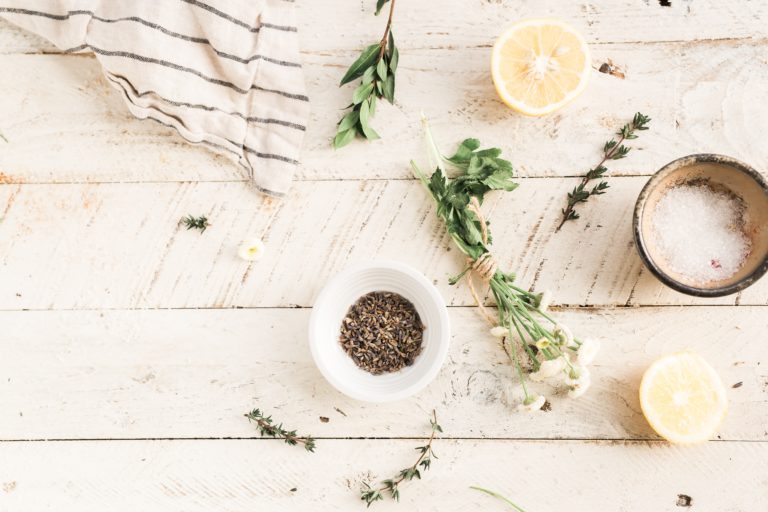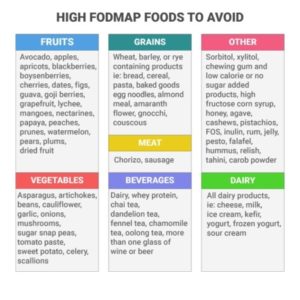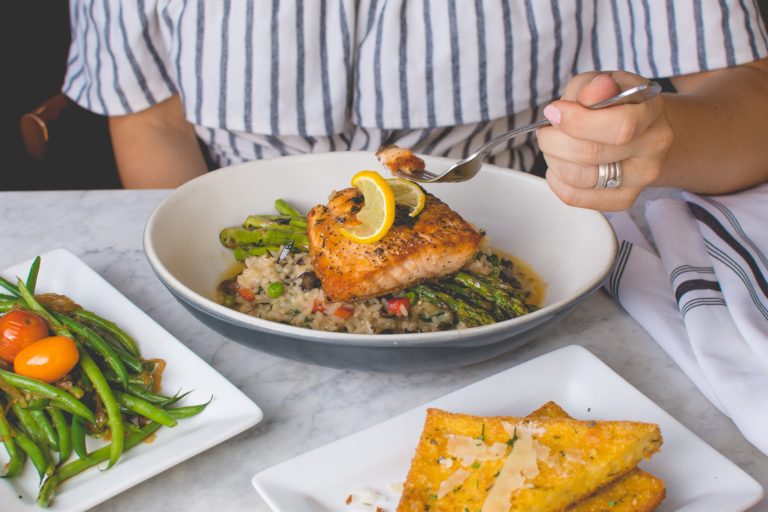Excerpt from Enlightened Weight Loss
Of course, you will want to indulge at times, and you don’t have to feel bad about that. Later on, we’ll cover “cheat days” and indulgent foods that fit into your meal plan. But you don’t want to be in a position where you feel powerless against your cravings or your desire to overeat. In this section, we’ll work on removing a lot of the factors that lead to cravings and overeating such as stress, dehydration, and lack of sleep. As well as ways to deal with cravings once they arise.
Stay Hydrated
Feeling thirsty is actually a late sign that you’re dehydrated. At first, dehydration can come out as a craving for food. Make sure you’re drinking enough water to prevent those cravings. Before you decide to indulge, drink some water first and see if your craving weakens.
Aside from regulating your appetite, it is necessary for you to drink enough water to digest your food and for almost every other function in your body. If you’re not drinking water because you don’t like the taste, then remember that it’s life-sustaining water. It doesn’t have to taste like a milkshake. But if you really can’t stand it, then try flavored seltzer or adding lemon, lime, or other fruit, or try flavored herbal cold brew tea bags to add to your water.
If you’re used to drinking juice and soda, water will seem boring. It will take some getting used to, however removing flavored drinks can save you a few hundred calories a day and a pound of fat per week.
If you don’t like cold water, then try naturally caffeine-free tea like rooibos, chamomile, peppermint, or flavored herbal teas. If you don’t drink enough fluids because it’s inconvenient for you to use the restroom, then try to hydrate when it’s convenient, like first thing in the morning.
How Much To Drink
If you’re drinking enough fluids, your urine should be clear at least once each day. You’ll feel more clear-headed, energized, and have fewer cravings. Keep track of your water intake on a few occasions to see if you’re drinking enough. To figure out how much you need, you can follow these general guidelines, use my online calculator[1] , or calculate it on your own with the steps below.

Hydration Equation
Step 1
Divide your body weight in half for how many ounces of fluid you need in a day.
Example: 150 pounds divided by 2 = 75 fluid ounces a day
Step 2
About 20% of your fluid comes from the food you eat, leaving the other 80% of your needs from fluids. So you can then calculate 80% of your total fluid needs.
Example: 75 fluid ounces x .80 = 60 fluid ounces from fluids a day
Step 3
Divide that number of ounces by the size container you usually drink from.
Example: 60 fluid ounces divided by 16.9 fluid ounce water bottle = 3.5 bottles a day.
Eat Enough
How many times have you tried to lose weight by restricting yourself as much as possible, just to gain it all back? It’s the most common and damaging weight loss mistake. The problem is that your body is designed to survive a lack of food by holding onto your fat stores for dear life. It doesn’t know the difference between a diet and a famine.
When you restrict too much, your body won’t readily give up your life-sustaining fat stores. It will actually do the opposite. Your body adapts to less food by slowing down your metabolism. It starts using less food for energy and stores more of it as fat for a later time. Additionally, it will increase your appetite so that you overindulge whenever more food becomes available again. The problem with a diet is that you aren’t actually starving, so there’s almost always plenty of food available.
Luckily there’s a way to lose weight without triggering these fat-saving and craving-inducing survival instincts. Later, you’ll learn how much you should be eating and other ways to prevent cravings and a slow down in your metabolism. You will probably be surprised to see how much you can eat while still losing weight.
Don’t Get Too Hungry
You might be proud of yourself for being able to ignore your hunger or suppress it all day with caffeine, gum, and water, however that is not helping you lose weight. This will be explained in more detail later on. For now, just understand that during your eating window, you should not wait until you’re very hungry before you eat something. Instead, you should always eat whenever you start to feel hungry. We’ll discuss eating windows in the next section.
If you haven’t already noticed, it is impossible to eat an appropriate portion size or make a healthy choice when you’re starving. I know that some of you don’t eat lunch until you’re about to pass out so that you have less time at work after your break. If you’re one of those people, then you should at least keep a snack at your desk like a piece of fruit to have when you start to feel hungry. Or carry them with you when you’re out of the house, so there’s no excuse to let yourself get too hungry.
Get To Know Your Early Hunger Signals
If you’re used to ignoring your hunger signals, then you might not know what they feel like. Early hunger signals aren’t the same for everyone. It can start by feeling like your stomach is empty. It can be very subtle and sometimes only last for a minute or two. If that’s the case, then it can be easy to ignore, especially when you’re busy. Pay close attention to that feeling, because that is when you should begin eating. If you ignore your early hunger signals you will become overly hungry, making it difficult to make a healthy choice, or eat an appropriate portion at an appropriate rate.
If You’re Always Hungry
The first hunger signals of the day will begin about 12 hours after dinner the night before. Then, three to five hours after each meal throughout the day, and one to two hours after a small snack. If you feel that you’re hungry more often, then it could be from a lack of sleep, medication, stress, not eating enough, or eating processed carbs or inflammatory foods. We’ll cover what to eat, how much to eat, and sleep later on, which will help to regulate your hunger.
If You’re Never Hungry
Having no hunger signals is not a good thing. It makes it hard to know when you should start eating, and when you should stop. If you never feel hungry, then it could be from ignoring those signals. If you ignore hunger signals for long enough, then your body won’t keep bothering you with them. You can even lose your hunger signals from having extra body fat because fat cells send out a hormone that suppresses your appetite. It could also be that you’re suppressing your hunger with things like caffeine, nicotine, gum, or medications.
If you’re not doing anything to suppress your appetite, but you still never feel hungry, then start by making a routine eating pattern. Losing weight and having some regularity will start to trigger your hunger signals.
Wait Until You’re Hungry
If you start eating out of boredom or because of a craving, then there’s no clear reason to stop eating. But if you start to eat when you’re hungry, then you’re more likely to stop eating when you feel full or satisfied. If you do have a craving, then at least try to wait until you start to feel hungry before you eat.
Eat Slowly
It takes a while for your brain to get the signal from your stomach that it’s full. If you eat too fast, then you can consume a large portion of food before you even begin to feel full.
If you eat slowly, your brain has time to receive the signal that your stomach is filling up. You will be able to feel full with much less food if you eat slowly.
If you’re used to eating fast, then use the guidance below to help you slow down. It is not an easy task at first, however like any habit it can be broken. Then, eating slowly will become your new habit.
How To Slow Down
- Don’t wait until you’re starving to eat. Eat when you just start to feel hungry.
- Take a few deep breaths before you eat and when you notice that you’re starting to eat fast again.
- If you notice you’re chewing fast and lost in your thoughts, then refocus on breathing, chewing, and tasting your food.
- Make sure you chew each bite thoroughly. Remember that you can’t properly digest the food that hasn’t been thoroughly broken down.
- Take small bites so that it’s easier to chew the whole mouthful before you get tired of the taste.
- Put your food or utensil down between bites.
- Focus on the food in your mouth, not the food on your plate.
- A lot of times, fast eating is because of stress. The next section will help to improve your mood and alleviate stress, which will naturally slow down your eating rate.
Stop Eating When You’re Comfortably Full
When you finish eating, you should feel comfortably full. If you don’t feel full at all, then you will end up craving something else. If you feel overly full, then you likely ate too much. Becoming overly full stretches the stomach which actually triggers hormones that increase your appetite.
If you tend to overeat, then follow the guidance below. Once you start to eat smaller portions, your stomach won’t shrink, but it will become less elastic. You will feel satisfied with less food, and it will become difficult for you to eat large portions again.
How To Prevent Overeating
- Pre portion your food. As a survival instinct, your brain will urge you to eat everything in sight.
- If you’re at a restaurant, place your napkin on your plate to cover your food when you feel satisfied, or ask for a to-go box with your meal and take whatever’s leftover. Removing the food from your sight will soften the brain’s hormonal craving response.
- Stand up and walk away from the food or put it away when you feel satisfied to give yourself time to become satisfied.
- Have a meal ender like a cup of tea, a hard candy, or a chocolate-covered mint. Brush your teeth, chew gum, or use mouthwash to cleanse your pallet.
Set Aside Time To Eat
Set aside around 15 to 20 minutes to eat each meal. Once you do this, you might be surprised to see that you’ve actually been eating your food in less than five minutes. If you’re eating your food this quickly, then you will have difficulty becoming full.
You should set aside time to eat, even if you’re a slow-eater. If you take too long to eat, then you’ll never feel full because the food is emptying out of your stomach at the same slow rate that it’s going in. The same thing happens if you’re just taking a few bites here and there while you’re doing other things. This is not to say that you can’t eat while you watch television or use the computer. However be sure to take your time to chew your food thoroughly and avoid taking long breaks between each bite.
Pay Attention To What You’re Eating
If you’re distracted when you’re eating, then you can easily eat an entire bag of chips without even enjoying it. You might not even realize what you were doing until there are no chips left. At that point, you won’t feel satisfied with the snack, even if you’re full. Mental satisfaction from eating is even more important than how full you are.
Once again, this is not to say that you can’t eat while you do anything else. You can still pay attention to what’s in your mouth while you sit in front of the television or computer. When you eat, chew thoroughly, and pay attention to tasting and breathing. You’ll probably have to keep reminding yourself at first, but it’ll become a habit.
Imagine Being Satisfied
Sometimes you might be lost in the pleasure of eating and be surprised and disappointed when there’s no more food left. You’ll look for something else to eat, even if you’re full.
While you eat, imagine feeling satisfied when you finish. Expect to feel satisfied. This will help you prevent the abrupt end of pleasure when you finish. If you know that you always crave something after your meals, then you can factor that into your meal plan or use a low-calorie meal ender like tea, a hard candy, or chocolate-covered mint.
Trick Yourself With Seconds
If you’re the type of person that doesn’t feel satisfied with one serving, then break your meals up into two portions. Have ¾ of your meal at first, and then serve yourself the rest as a second portion. This will make you feel like you’re eating more, even if it’s the same amount of food.
Don’t Eat Boring Food
If your food is bland, then you’ll end up hating your diet. There’s plenty of room for flavor in your weight loss plan. If you do your own cooking, then you can use the recipes from the free meal plans on my website or from other sources. If you always order take out or if you usually go to restaurants, your only option is not boiled chicken and vegetables. You can get something indulgent that fits into your calorie range. Be sure to include some vegetables, even if you’re getting them as a side dish.
Fit In A Treat
You don’t have to feel guilty if you’re not ready to give up daily junk food. There’s always a way to fit something into your plan. Knowing that there’s a treat scheduled into your day will help you avoid each temptation that comes along.
Distract Yourself
Your brain’s reward center can be triggered whenever you see, smell, or think about something pleasurable. Do you notice what happens when someone gives you a treat, or there’re snacks in the break room? Even if you weren’t craving anything before, you feel deprived if you don’t have it.
If you want to avoid indulging or overeating, then your best bet is to distract yourself and get it out of sight. If you’re still craving it, then don’t talk to yourself about it even if it’s to tell yourself not to eat it.
If you’re thinking about it, you’ll keep wanting it because the thought of the food is still triggering your reward center.
As soon as the craving comes up, focus your attention on something else until it goes away. Distract yourself with anything, like watching something funny, talking to someone, listening to music, taking a walk, drinking tea, or even meditating, which we’ll cover later in this section. The craving won’t last forever.
Don’t Say “I Can’t”
If you tell yourself you can’t have something, it will make you crave it even more. The truth is, you can have indulgent food and still lose weight, just not all the time. Be very careful with your thoughts. If you want a double cheeseburger, don’t tell yourself you can’t have it. Change the thought to something like:
“I could have that now if I want. But I’d rather eat something healthier. I can have a treat later if I want, but it’s not worth it right now.”
Don’t Say “I Have To”
Don’t tell yourself that you have to eat healthily. If you have to do something, it implies that you don’t want to, and it’s not true. You might have to go to work, so you don’t get fired, but there’s no immediate consequence of eating a cheeseburger instead of a salad.
Change the thought to something like:
“I’d rather have a salad so I can get some nutrients and feel full without going over on calories.”
Once you finish eating and you feel full, the desire will be gone or at least diminished.
Stop Feeling Guilty
You won’t be perfect all the time, and you don’t have to be. Sometimes you might overeat, or get off track for a few days, which is normal. Feeling guilty and beating yourself up is just a way of telling yourself that you’re not in control. But that’s not the case. You’re just in the process of making new habits.
Instead of beating yourself up, take note of how you feel. Overeating doesn’t feel good. Neither does getting off track and gaining a few pounds. If you associate that feeling with steering away from your plan then you will be much less likely to do it again in the future.
Don’t Romanticize Unhealthy Food
Be more realistic with how you think about foods like cookies and pizza. Whatever your “weaknesses” are. Notice how they actually taste, and how you feel while you’re eating them. It’s not the taste of the food that’s creating the feeling. The reward center of your brain is tricking you with dopamine, making you feel happy.
It will make you think about the food though you’re in love with it. You’ll be associating those foods with the taste, the reward it gives your brain and love. Resisting them becomes even more difficult. Yes, the food tastes good, however, become aware of the dialogue you use about your food. Recognize that it is not love but rather a survival trick of the mind.












